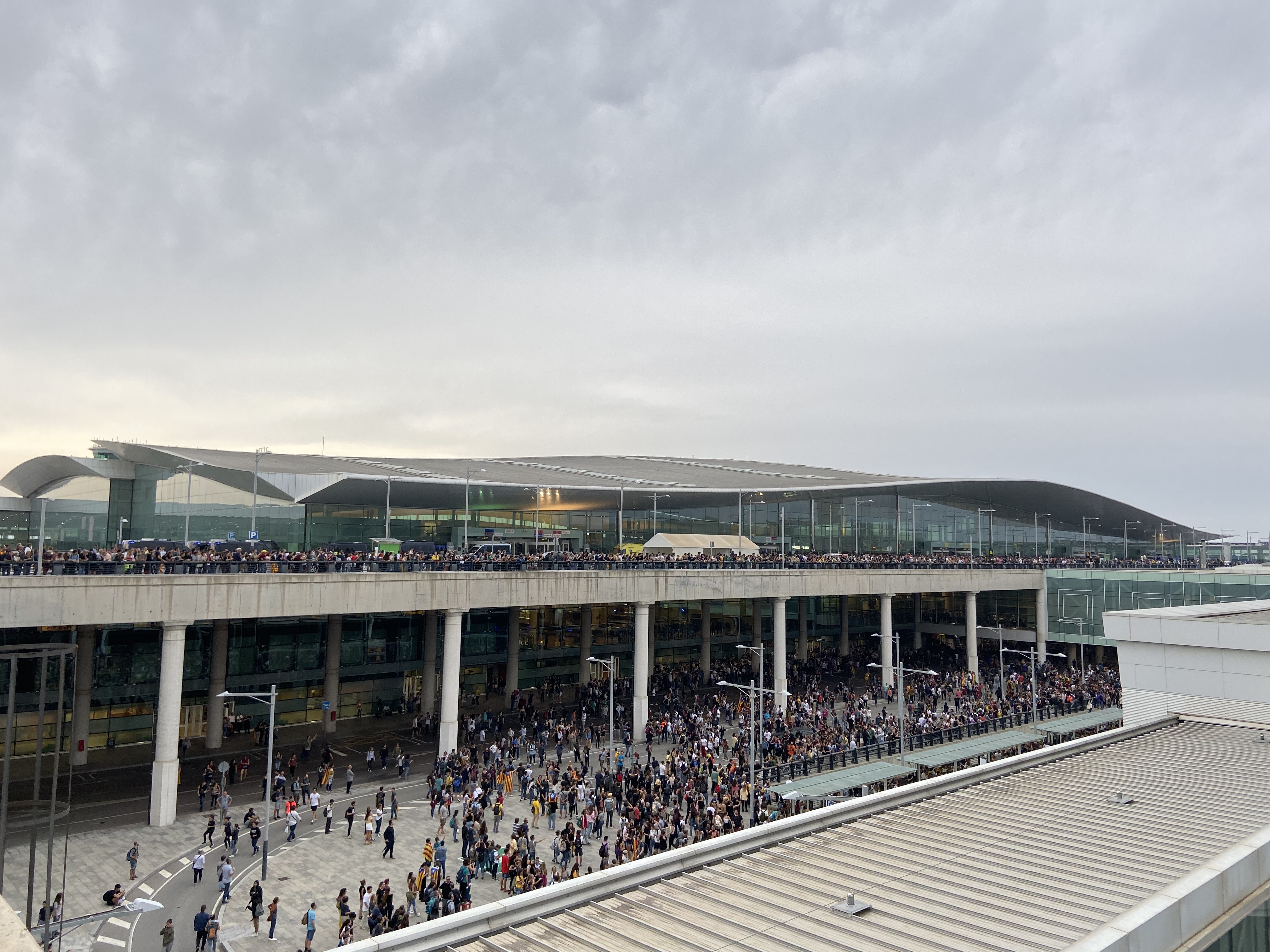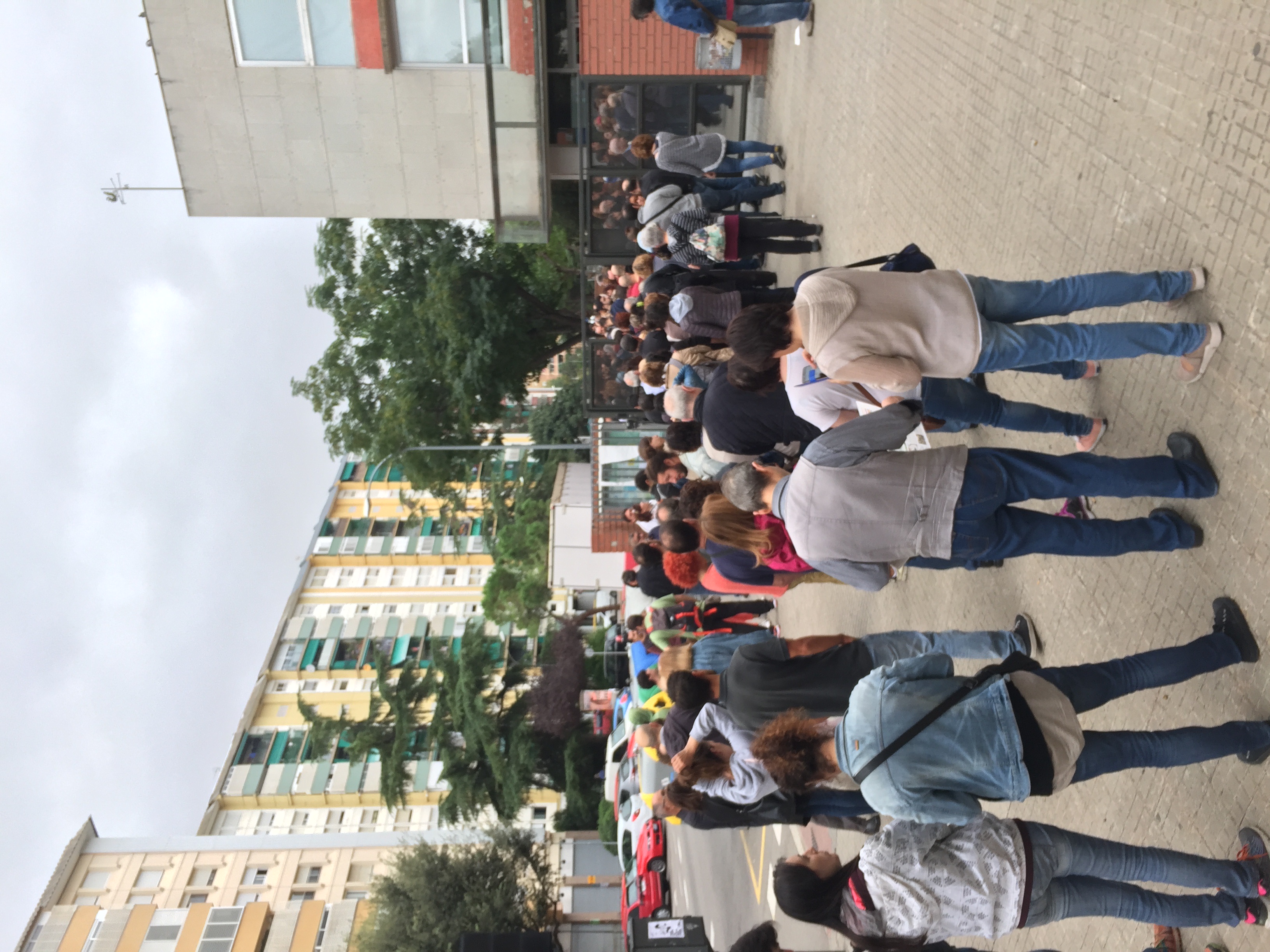Last Monday’s sentencing of Catalan political and civic leaders to years in jail led to a week of protests and riots in Barcelona and other Catalan cities. The week started with the sentences, at around 0930 on Monday. At 1300, I headed down to Plaça Catalunya with two colleagues, to see take part in a demonstration organized by the new, online blockchain-powered protest movement Tsunami Democràtic. Before long we learned that the action itself wasn’t to be a simple demo in Plaça Catalunya, but an occupation of the airport.
“Tots a l’aeroport!”
So we headed up to Gran Via and joined the hundreds of people there, already making their way down towards Plaça Espanya and beyond. We continued to walk down Gran Via as it turned into a motorway – it’s always a strange feeling to walk along the motorway – particularly as part of a spontaneous demonstration. It took about 3 1/2 hours to walk from Plaça Espanya to the airport’s main terminal, by which time we were thousands of protesters. We walked up the closest ramp to the departures area, but stayed back from the heart of the protest, where demonstrators were facing off with a thin line of Mossos attempting to limit the movement of the crowd. While we looked on, this police cordon broke, resulting in a surge of protesters from the left of our field of view, to the right.
This was followed by the first of several baton charges that we witnessed, and the arrival of more police vans. Around this time, I saw and heard police firing what were probably ‘foam’ pellets, a type of non-lethal crowd suppressant. They can still cause serious injuries.
It was the first time I’ve ever seen protesters fired on, in more than 20 years of participation in demonstrations.

As heavy rain set in, my colleagues and I decided to head back to Terminal 2 and try to get a train back into the city. It was another long walk, this time something of a trudge, with our clothes and shoes wet through. Thousands more protesters were arriving as we left, and some called out to us to stay a bit longer. “You’re the evening shift: we’ve already done our bit”, we called back, and this was met warmly. While many had used cars and the metro to get close to the airport, we had actually walked all the way, and deserved a rest.
Also, we were all a lot older than many of the protesters arriving. The average age can’t have been much more than 18 or 19, and many were basically kids: teenagers of 14, 15. There was a sense of excitement, of exaltation rather than trepidation. After an uproarious response to a brief police maneuver, some lads next to me nudged each other and grinning called out “Come on, let’s get down there!”, before running out into the fray. This, coupled with knowledge of the violent and often far-right BRIMO, meant I was not surprised when more trouble broke out later.
Foam rounds fired at #barcelonaairport #TsunamicDemocratic pic.twitter.com/zpLwpWKaZS
— Tom Clarke ?? (@tombcn) October 14, 2019
There is a lot of frustration out there. I mean, old fogeys like me are frustrated so imagine how bad it must be for teenagers who’ve grown up in constant economic and political crisis, the only remedy being police sanctioned clubs where marijuana can be more or less legally consumed.
I got home at about 2100, having walked 25 km. The number of protesters at the airport swelled, and finally the police moved to retake the space, triggering some disturbances. The demonstration was officially called off at maybe 2200 or 2300, and I think it took a few more hours to clear the space in front of the airport. In all, 155 flights were cancelled.
Policing context
Monday saw the start of riots and disturbances in Barcelona and throughout Catalonia and Spain. What started as simple protests against the prison sentences became demonstrations against police violence and in support of the right to peaceful assembly, and these then turned into violent confrontations, which have left hundreds injured (including police officers). 4 protesters have lost eyes thanks to police use of rubber ball ammunition. Sunday was the first night in a week without violent altercations.
Actually, the style of policing was presaged by a few events prior to the sentences. Firstly, we had the arrests of 9 CDR activists accused of terrorism by the state. This was another step in the campaign to demonize the CDRs and the whole independence movement as violent or at least potentially violent. Another aim might well be to split the independence movement but I’d say that it has responded pretty much unanimously by rejecting the arrests in disbelief. If there is a split, currently, it lies between the people on the streets and the main political parties (ERC and JxCAT). More on that later.
The next, and perhaps most important foreshadowing of last week’s police violence came from the head of the Guardia Civil in Catalonia, Pedro Garrido. In an almost unthinkable breach of protocol, one of Spain’s most senior security officials plunged head first into politics, giving an openly political speech and warning Catalan independentists that his force would “Do it again”, a macabre echo of Jordi Cuixart’s words about the October 1 2017 referendum. Cuixart had referred to voting. Garrido, presumably to beating the shit out of peaceful protesters.
Last week
In the end, it was the Mossos and the Policía Nacional who handled the brutal repression this week. Much of the time, they appeared to be running amock, completely out of control.
You can view some videos of the week’s violence here: https://catalanrepression.github.io
Friday, we observed a general strike. As an aside, I recently became a union member for the first time, and it’s a great feeling to be part of an organized labor organization. More on that later, too.
I joined one of six ‘marches for liberty’ which converged on Barcelona, and ending with another large demonstration in the city center. Another 15 km walked, in the name of democracy.
Incredibly friendly and festive feeling matching into Barcelona. Some neighbours cheering us on from their balconies ? #marxaperlallibertat pic.twitter.com/E9NBlb6nB4
— Tom Clarke ?? (@tombcn) October 18, 2019
As we marched into the city, some neighbors cheered us on from their balconies.
